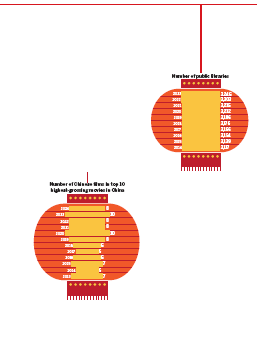China counts its cultural achievements
National progress in developing public facilities has proceeded at a rapid pace since 2012. Yang Feiyue reports.
By Yang Feiyue | China Daily | Updated: 2024-09-30 13:25

Reading spaces
With a substantial collection of more than 8 million books, the Beijing Library lures large crowds with highlighting experiences ranging from trying on Peking Opera costumes and watching shadow puppet shows, to interacting with the digital image of writer Lu Xun (1881-1936).
According to its operators, between its opening in late December and July 10, the library, which is located in the Tongzhou district in the east of the capital, has packed in more than 2 million visits. To enliven the reader experience, it has also hosted 1,300 events that have attracted more than 4 million visitors.
It is part of the capital's efforts to boost reading and satisfy the needs of readers.
Since the First National Conference on Reading was held in Beijing in 2022, authorities have issued support policies to improve infrastructure and foster an environment conducive to reading.
The city currently has more than 2,000 bookstores, which translates to an average of 0.9 bookstores per 10,000 people, higher than many other international cities like New York or Paris.
In Shanghai, the city's first 24-hour park library in Heping has had around 4,500 visitors on a daily basis since it opened in April.
In addition to literature, the Heping library has evolved into a new public cultural space thanks to its fashionable design that is accentuated by its park setting.
"Unlike bookstores or cafes, this is a public library and a nonprofit institution, so people are more relaxed here," said Deng Geng, who frequents the library. The 20-something has seen many people there, even after midnight.
Han Yao, who works at the library, believes its biggest spillover effect is attracting people who may not have spent time at a library before. Visitors might come to the park to enjoy themselves, and then end up getting a membership card, as well.
The two libraries are among an increasing number of facilities that cater to the rising public need for cultural experiences.
Public libraries have continued to innovate and develop, carving out their own path in promoting reading and creating a public cultural service system, experts said.
Currently, major indicators such as the total built area of public libraries, the number of facilities, and the size of collections, rank first in the world, while indicators such as electronic resources are close to advanced global levels, said Chen Ying, deputy director of the National Library of China.
In developed regions like Beijing, Shanghai, Zhejiang, and Guangdong, the level of development of public libraries not only compares favorably with the world's most advanced cities, but even surpasses them in some aspects, Chen added.
Wu Zhinan, a cultural and tourism public service expert and a researcher at the Shanghai Academy of Social Sciences, said that China has made great strides in creating a modern public cultural service system since the 18th CPC National Congress, and added that the development of the public cultural infrastructure network has advanced rapidly, and the production of public cultural products has become increasingly diverse.
As a result, the satisfaction of urban and rural residents with public cultural services has significantly improved.
China has built more than 3,200 public libraries, according to data from the National Bureau of Statistics.
























